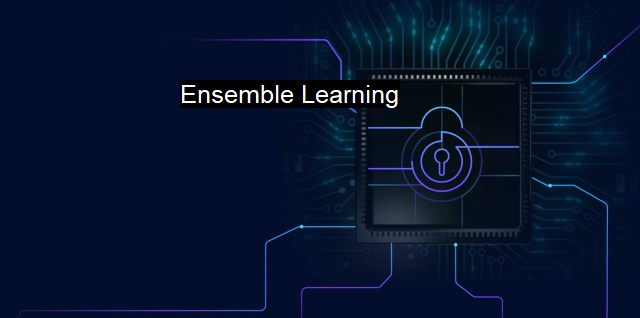What is Ensemble Learning?
Enhancing Cybersecurity with Ensemble Learning: Combining Models to Detect Rapidly Evolving Threats
Ensemble Learning is an advanced machine learning concept that strategically consolidates various individual learning algorithms or 'weak learners ' harmoniously to develop a significantly stronger predictive model or 'a strong learner'. It essentially implies that multiple weak learning algorithms collaboratively sum up to significantly enhance the accuracy and efficiency of predictive analytics in diverse fields, including cybersecurity and antivirus solutions.Amid burgeoning threats, ensemble learning serves as a highly potent and disruptive technological approach that can considerably enhance the efficiency and effectiveness of antivirus software and cybersecurity practices. The technique provides a solution for continuously evolving cyber threats by combining the predictions from multiple machine learning models to produce a single robust predictive output which improves the generalization properties of individual models.
Ensemble models offset the inefficiencies inherent in single predictive models, which often entail issues of overfitting, underfitting, bias, and insignificant influence of noise, among others. By implementing multiple learning techniques, ensemble learning diversifies the interpretation and handling of input data, thus overcoming these singular vulnerabilities. By leveraging the collective strengths of each model and eliminating their individual weaknesses, ensemble learning offers a formidable solution capable of discerning complex patterns more effectively assigned to detect potentially malicious behavior.
One way ensemble learning practically impacts cybersecurity is through improving Antivirus software capabilities. Traditional antivirus solutions are typically designed to identify and neutralize known threats by leveraging a repository of virus signatures - a method best suited for combating yesteryear's threats. This traditional signature-based approach is relatively less effective when it comes to evolving, polymorphous malware, or zero-day attacks that do not conform to any known signature.
In ensemble learning-based solutions, antivirus software gains a predictive edge as it is capable of leveraging the systematic combination of different data interpretations conducted by a group of diversified models. These models elicit various responses towards the data based on their unique learning and feature selection techniques, offering a broad-based threat detection mechanism. This enhances the discovery capability regarding the types, structures, and behaviors of potentially harmful entities, thereby improving early malware detection rates. This multiple classification system offers an improvement in speed and a reduction in false-positive rates, which traditionally plague antivirus software.
In the grand scheme of cybersecurity, ensemble learning-based frameworks also help improve anomaly detection in corporate networks. By monitoring system behavior, actions, and data traffic and their temporal and spatial relationships within a network using multiple learners, these systems can provide more accurate detection of abnormal or novel activities. In turn, this could flag potential cyber threats, safeguarding the network from breaches or attacks before escalation.
Despite its efficiency, ensemble methods require careful design, selection and maintenance of learning algorithms for optimal functioning. The models should be diverse but accurate, bringing identified correlation and coverage of the entire feature space. The ensemble should also be well equipped in handling high-dimensionality, which is necessary for cybersecurity due to the enormity and complexity of network traffic data.
Ensemble Learning shows great potential as an effective method in the continuous battle against cyber threats. It capitalizes on the diversity, accuracy and ubiquitous coverage of multiple models to successfully scrutinize, learn and predict from evolving data in cybersecurity and antivirus solutions. The innate capability of ensemble learning models to offset individual learner irregularities while tapping into their collective strength makes it a powerful tool for detecting anomalies and preventing potential cybersecurity threats in an increasingly networked world.

Ensemble Learning FAQs
What is ensemble learning in the context of cybersecurity and antivirus?
Ensemble learning in cybersecurity and antivirus refers to the use of multiple machine learning models and techniques to improve the accuracy and effectiveness of threat detection and classification. Rather than relying on a single algorithm, ensemble learning combines the results of multiple models to make more accurate decisions.How does ensemble learning improve the accuracy of threat detection?
Ensemble learning combines the results of multiple machine learning models that specialize in different areas of threat detection or classification. By combining the results of these models, ensemble learning can better identify potential threats and reduce the number of false positives.What are some examples of ensemble learning techniques used in cybersecurity and antivirus?
Some examples of ensemble learning techniques used in cybersecurity and antivirus include bagging, boosting, and stacking. Bagging involves combining the results of multiple models trained on random subsets of the data to reduce the risk of overfitting. Boosting involves training multiple models sequentially, with each subsequent model focusing on the errors of the previous model. Stacking involves combining the results of multiple models using another machine learning model.Are there any drawbacks to using ensemble learning in cybersecurity and antivirus?
One potential drawback of ensemble learning is that it can be computationally expensive and time-consuming to train and run multiple machine learning models. Additionally, the results of ensemble learning can be difficult to interpret, making it challenging to understand why a particular decision was made. Finally, if one of the models in the ensemble is flawed or compromised, it can negatively impact the accuracy of the entire system.| | A | | | B | | | C | | | D | | | E | | | F | | | G | | | H | | | I | | | J | | | K | | | L | | | M | |
| | N | | | O | | | P | | | Q | | | R | | | S | | | T | | | U | | | V | | | W | | | X | | | Y | | | Z | |
| | 1 | | | 2 | | | 3 | | | 4 | | | 7 | | | 8 | | |||||||